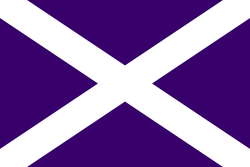Alkali
This article refers to a micronation or element of micronationalism which is defunct and no longer exists. You can help make the article reflect that or ask on the talk page for further information. |
Alkali | |
|---|---|
State | |
 Flag of Alkali | |
| Country | Union of Mountain States |
| Population | |
| • Total | N/A |
Alkali was a state in the Union of Mountain States, it began existing after Mountain States defeated the Socialist Republic of Alkali in the Valley Integration. The state of Alkali dissolved on 3 March 2020 when the Union of Mountain States dissolved under president Jebediah Powell when the Union of Mountain States was experiencing intense stagnation and were unable to function.
History
The Valley Integration
The rapid expansion of the Union of Mountain States caused the Socialist Republic of Alkali and the Republic of Alcton to protest against the Union of Mountain States because they were irritated by their expansionist movements, causing tension to form. On 11 June 2019, the tension caused the Union of Mountain States to declare war on the Socialist Republic of Alkali and the Republic of Alcton. The Union of Mountain States brought their soldiers to launch an attack on the Republic of Alcton on the 15th of June. The Republic of Alcton would surrender because they only had one soldier. On the 4th of July, the Union of Mountain States launched an assault on the Socialist Republic of Alkali and launched an attack into unmanned Alkali lines. The operation caused the Socialist Republic of Alkali to surrender to the Union of Mountain States on 9 July 2019.
Aftermath of the Valley Integration
The Republic of Alcton was split into two different things: Independent Kronstam and the Reorganized Nationalistic Alcton. The Socialist Republic of Alkali was annexed by the Union of Mountain States, ending the conflict with a victory by the Union of Mountain States.
Geography and Climate
Union of Mountain States
The Union of Mountain States had a large variety of geography and climate, for some states were in the western United States and some were in the eastern United States. The western states were in a large valley area, mostly being shrub land with the exception of marshes. The western states had hot and arid temperatures during the summer, and cold, dry winters. The eastern portion was made up of dense forests with high biodiversity. The climate was moderate, having humid summers and insignificant winters.